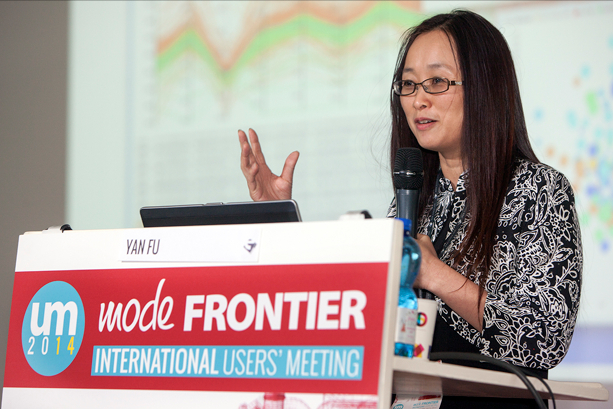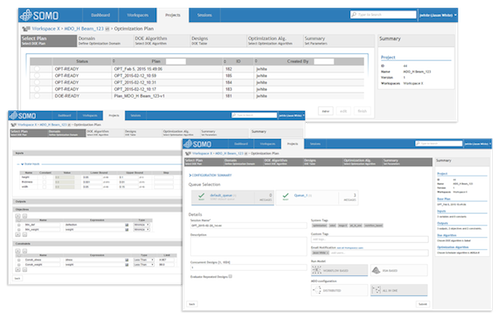
Ford’s Yan Fu explains the auto maker’s vision for an Enterprise Multidisciplinary Design Optimization (EMDO) system built around ESTECO’s modeFRONTIER and SOMO platforms. Image Courtesy of ESTECO
Latest News
March 2, 2015
As multidisciplinary optimization spreads throughout all corners of its design process, Ford Motor Co. has adopted a new platform aimed at streamlining optimization collaboration across a global design team while making MDO processes an enterprise best practice.
Building on its decades-long MDO work with ESTECO’s modeFRONTIER, the auto giant is now implementing SOMO, an enterprise collaboration and distributed execution framework born from the pair’s partnership and now a commercial piece of software. SOMO delivers the enterprise foundation that extends Ford’s MDO efforts from their roots as an individual, desktop focused-task to a web-enabled solution capable of satisfying all the design needs of a global enterprise, according to Yan Fu, Ford’s technical leader of business strategy and engineering optimization.
 Ford’s Yan Fu explains the auto maker’s vision for an Enterprise Multidisciplinary Design Optimization (EMDO) system built around ESTECO’s modeFRONTIER and SOMO platforms. Image Courtesy of ESTECO
Ford’s Yan Fu explains the auto maker’s vision for an Enterprise Multidisciplinary Design Optimization (EMDO) system built around ESTECO’s modeFRONTIER and SOMO platforms. Image Courtesy of ESTECO“SOMO’s mobile and web interfaces simplify access for non-MDO experts, helping provide visibility to all optimization processes and results,” explained Matteo Nicolich, product manager for enterprise solutions at ESTECO. “SOMO provides the enterprise piece, extending MDO knowledge to others within the organization.”
modeFRONTIER has been widely deployed within Ford for years, helping cross-functional engineering teams make informed design tradeoffs that help reduce vehicle weight, increase fuel efficiency, and ensure optimal levels of safety, NVH (noise, vibration and harshness), durability and comfort standards. During early efforts to make optimization a best practice, Ford initially coordinated the MDO work of cross-functional teams through a manual process heavily reliant on meetings. Eventually, that effort evolved into a more structured approach that tasked a formal MDO group with collecting models and requirements of multiple attribute design teams into a single environment, that being modeFRONTIER, Fu said.
While having a team of MDO experts was beneficial, there was still a lot of manual effort required to coordinate efficient MDO processes, not to mention the fact that the key domain-specific knowledge stayed with the appointed MDO experts. “This can lead to bottlenecks in the process,” she said. “Just imagine what happens when an expert leaves the company or is absent from work—the entire project can suffer from huge delays. If you don’t have the appropriate technological tools to handle this kind of information flow, the global product development time milestone might be missed.”
Enterprise Multidisciplinary Design Optimization (EMDO) built around SOMO provides a secure, efficient system that automates the process and prevents human error. Moreover, MDO knowledge is captured through standardized templates, which helps get new employees up to speed and enables Ford to pool its best resources from around the world, funneling their knowledge throughout all facets of the design process, Fu explained.
 ESTECO’s SOMO platform takes Ford’s MDO efforts to the next level by streamlining information flow and facilitating optimization collaboration across a global design team. Image Courtesy of ESTECO
ESTECO’s SOMO platform takes Ford’s MDO efforts to the next level by streamlining information flow and facilitating optimization collaboration across a global design team. Image Courtesy of ESTECO“MDO processes become institutionalized and transparent, with engineers truly able to focus on their work without depending on the schedules of other department experts,” she said. “Actual models and data become centralized—the so-called, ‘single source of truth.’”
A recent pilot project illustrates how the combination of modeFRONTIER and SOMO create an EMDO process that delivers benefits to Ford engineers. Used in the design of a bigger model pickup truck, the optimization analysis comprised three different truck sizes with the aim of minimizing the weight while meeting all constraints relating to safety, NVH and durability. The final optimization workflow included seven models, 113 variables and 34 responses—a workload that would have taken at least a month to complete with traditional MDO processes.
With SOMO integrated into the Ford private cloud, different engineers do their own work and publish their latest models to the shared platform so the entire team can build the top-level MDO process right away. Now, running a single model simulation for one safety mode takes about three hours using 32 CPUs while execution of the entire multidisciplinary optimization takes about eight days. “This is something new that has revolutionized our way of working,” Fu said.
Check out this video to hear Fu describe Ford’s EMDO process.
Subscribe to our FREE magazine, FREE email newsletters or both!
Latest News
About the Author
Beth Stackpole is a contributing editor to Digital Engineering. Send e-mail about this article to [email protected].
Follow DE





